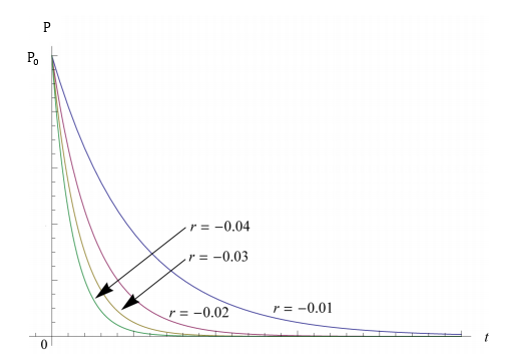Before logistic model
After the discussion of the background information relating to population projection, we are going to take a close look at one of the most famous mathematical models for population projection: the logistic model. In order to understand the logistic model, we need to understand exponential model first, since the logistic model is developed based on the exponential model.
The significance of the exponential model is to reflect a geometric population growth, which is inherited by the logistic model. The geometric population growth is first proposed in 1798 by Thomas Robert Malthus in his An Essay on the Principle of Population, as It Affects the Future Improvement of Society, With Remarks on the Speculations of Mr. Godwin, Mr. Condorcet and Other Writers. He stated that “Population, when unchecked, increased in a geometric ratio.” He also believed that “Subsistence increases only in an arithmetical ratio.” Therefore, Malthus predicted that human society will eventually end up with famine. This publication had tremendous influences on studies of population and it made Malthus become the founder of the exponential population model.
The exponential population model has the following form:$ P(t)=P_0e^rt. $
According to Wikipedia, the Malthusian population model has the following form:
Where
- $ P_0=P(0) $ is the initial population size,
- $ r $is the population growth rate, also known as Malthusian Parameter,
- $ t $ is the time.
This model can also be described by the differential equation:$ \frac{dP}{dt}=rP $
The solution of this differential equation will lead to the model above. The solving process is shown below:
<center> $ \ln{\left|P\left(T\right)\right|-\ln{\left|P\left(0\right)\right|=}}\left(rT+c\right)-\left(r\ast0+c\right) $
<center> $ \ln{\left|P\left(T\right)\right|-\ln{\left|P\left(0\right)\right|=}}\ rT $
<center> $ e^{\ln{\left|P\left(T\right)\right|-\ln{\left|P\left(0\right)\right|}}}=e^{rT} $
<center> $ \frac{P(T)}{P(0)}\ =\ e^{rT} $As $ P(T) $ and $ P(0) $ are all positive, the solution is:$ P(t)=P_0e^{rt} $
The population growth rate is the deterministic factor in this model. Following are graphs of the population with different growth rate:
Figure 4.1. The Exponential with positive population growth rate. Adapted from “Mathematical Models in Population Dynamics,” by Alexander Salisbury.
Figure 4.2. The Exponential with positive population growth rate. Adapted from “Mathematical Models in Population Dynamics,” by Alexander Salisbury.
The x-axis is representing the time, and the y-axis is the population. With positive r, the bigger the r is, the more dramatic the population growth is. With negative r, the bigger the r is, the smoother the population decay is. This growth rate is also essential in the logistic model, discussed in the later sessions.
Although Malthus’ idea is influential, the model itself is not practical. The model made following assumptions: “the population is homogeneous (i.e., all members are identical); the population inhabits a uniform and unvarying environment; an infinite supply of nutrients is available; there are no spatial limitations, and growth is density-independent.” In reality, those assumptions can easily be broken in the long term. Hence, more realistic models are desired.



